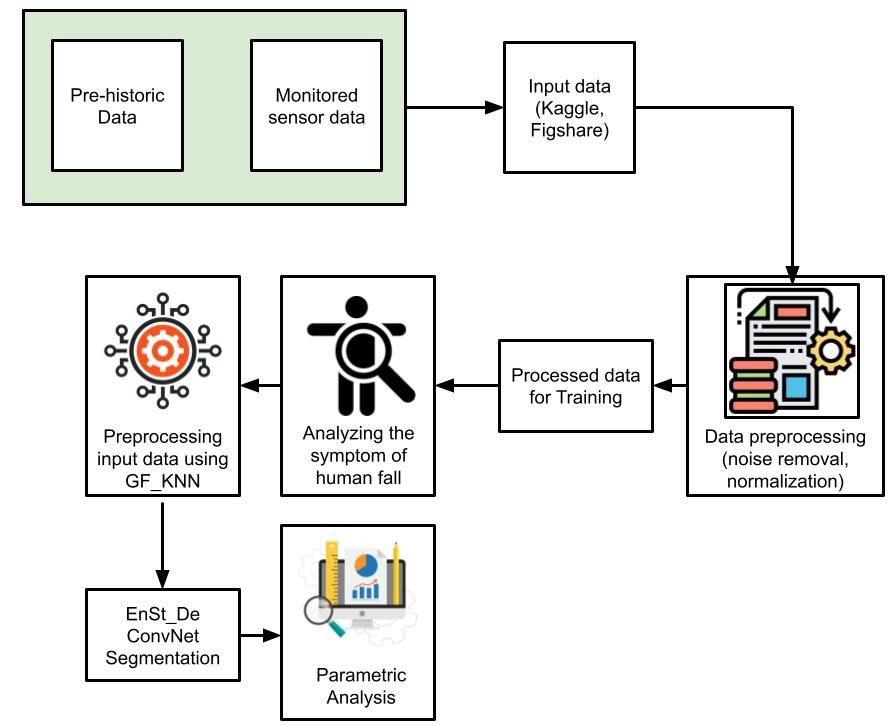Analysis for Symptoms of Human Fall using Pre-Processing and Segmentation based on Deep Learning Architectures
Main Article Content
Abstract
By building sensor-based alert systems, physical therapists can not only decrease the after-fall repercussions but even save lives.Older people are prone to several diseases, and falling is a regular occurrence for them during this period.Various fall detection systems have recently been developed, with computer vision-based approaches being one of the most promising and effective. Here, the sensor-based data has been analysed for a patient's human fall symptoms. This data has been pre-processed using Gaussian filtering with kernel neural network in which the data has been normalized and trained based on neural network. The trained normalized data has been segmented using encoded Stacked Deconvolutional Network (EnSt-DeConvNet). We found that the suggested method predicts such fall symptoms with the highest accuracy from sensor data. Other algorithms' accuracy results, on the other hand, are also fairly close. Experiments reveal that the suggested technique, when compared to other generally utilized techniques based on multiple cameras fall dataset, produced reliable findings and that our dataset, which consists of more training samples, produced even better results. Experimental results showaccuracy of 96%, Precision of 94%, Recall of 88% and F-1 score of 82%, computational time of 69%.
Article Details
References
Santos, G. L., Endo, P. T., Monteiro, K. H. D. C., Rocha, E. D. S., Silva, I., & Lynn, T. (2019). Accelerometer-based human fall detection using convolutional neural networks. Sensors, 19(7), 1644.
Shu, F., & Shu, J. (2021). An eight-camera fall detection system using human fall pattern recognition via machine learning by a low-cost android box. Scientific reports, 11(1), 1-17.
Kong, Y., Huang, J., Huang, S., Wei, Z., & Wang, S. (2019). Learning spatiotemporal representations for human fall detection in surveillance video. Journal of Visual Communication and Image Representation, 59, 215-230.
Savadkoohi, M., Oladunni, T., & Thompson, L. A. (2021). Deep neural networks for human’s fall-risk prediction using force-plate time series signal. Expert Systems with Applications, 182, 115220.
Saxena, U., Moulik, S., Nayak, S. R., Hanne, T., & Sinha Roy, D. (2021). Ensemble-Based Machine Learning for Predicting Sudden Human Fall Using Health Data. Mathematical Problems in Engineering, 2021.
Souza, P. V. C., Guimaraes, A. J., Araujo, V. S., Batista, L. O., & Rezende, T. S. (2020). An interpretable machine learning model for human fall detection systems using hybrid intelligent models. In Challenges and Trends in Multimodal Fall Detection for Healthcare (pp. 181-205). Springer, Cham.
Ali, S. F., Khan, R., Mahmood, A., Hassan, M. T., & Jeon, M. (2018). Using temporal covariance of motion and geometric features via boosting for human fall detection. Sensors, 18(6), 1918.
Mauldin, T. R., Canby, M. E., Metsis, V., Ngu, A. H., & Rivera, C. C. (2018). SmartFall: A smartwatch-based fall detection system using deep learning. Sensors, 18(10), 3363.
Soni, M., Chauhan, S., Bajpai, B., & Puri, T. (2020, September). An approach to enhance fall detection using machine learning classifier. In 2020 12th International Conference on Computational Intelligence and Communication Networks (CICN) (pp. 229-233). IEEE.
Zhang, J., Wu, C., & Wang, Y. (2020). Human fall detection based on body posture spatio-temporal evolution. Sensors, 20(3), 946.
Xu, Q., Huang, G., Yu, M., & Guo, Y. (2020). Fall prediction based on key points of human bones. Physica A: Statistical Mechanics and its Applications, 540, 123205.
Singh, K., Rajput, A., & Sharma, S. (2019). Human fall detection using machine learning methods: a survey. Int. J. Math. Eng. Manag. Sci, 5, 161-180.
Nizam, Y., Mohd, M. N. H., & Jamil, M. (2018). Development of a user-adaptable human fall detection based on fall risk levels using depth sensor. Sensors, 18(7), 2260.
Sarabia-Jácome, D., Usach, R., Palau, C. E., &Esteve, M. (2020). Highly-efficient fog-based deep learning AAL fall detection system. Internet of Things, 11, 100185.
Espinosa, R., Ponce, H., Gutiérrez, S., Martínez-Villaseñor, L., Brieva, J., & Moya-Albor, E. (2019). A vision-based approach for fall detection using multiple cameras and convolutional neural networks: A case study using the UP-Fall detection dataset. Computers in biology and medicine, 115, 103520.
Sampath Dakshina Murthy, A., Karthikeyan, T., & Vinoth Kanna, R. (2021). Gait-based person fall prediction using deep learning approach. Soft Computing, 1-9.
Panahi, L., &Ghods, V. (2018). Human fall detection using machine vision techniques on RGB–D images. Biomedical Signal Processing and Control, 44, 146-153.
Fan, K., Wang, P., & Zhuang, S. (2019). Human fall detection using slow feature analysis. Multimedia Tools and Applications, 78(7), 9101-9128.
Delgado-Escano, R., Castro, F. M., Cozar, J. R., Marin-Jimenez, M. J., Guil, N., &Casilari, E. (2020). A cross-dataset deep learning-based classifier for people fall detection and identification. Computer methods and programs in biomedicine, 184, 105265.
Ribeiro, O., Gomes, L., & Vale, Z. (2022). IoT-Based Human Fall Detection System. Electronics, 11(4), 592.
Hadjadji, B., Saumard, M., & Aron, M. (2022). Multi-oriented run length based static and dynamic features fused with Choquet fuzzy integral for human fall detection in videos. Journal of Visual Communication and Image Representation, 82, 103375.
Paul Ijjina, E. (2022). Human Fall Detection in Depth-Videos Using Temporal Templates and Convolutional Neural Networks. In Advances in Assistive Technologies (pp. 217-236). Springer, Cham.
Yadav, S. K., Luthra, A., Tiwari, K., Pandey, H. M., & Akbar, S. A. (2022). ARFDNet: An efficient activity recognition & fall detection system using latent feature pooling. Knowledge-Based Systems, 239, 107948.
Ezatzadeh, S., Keyvanpour, M. R., &Shojaedini, S. V. (2021). A human fall detection framework based on multi-camera fusion. Journal of Experimental & Theoretical Artificial Intelligence, 1-20.

